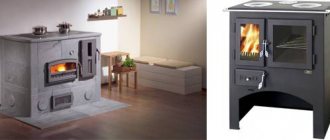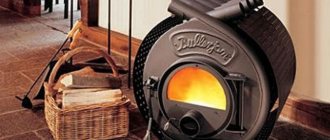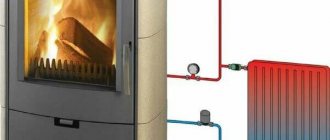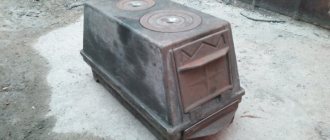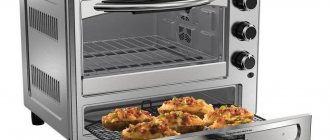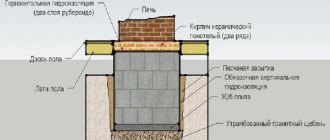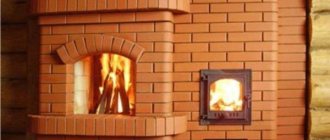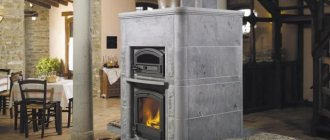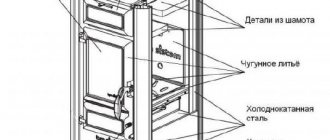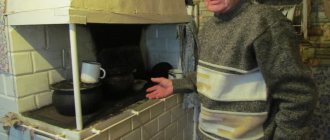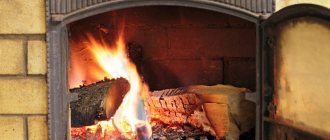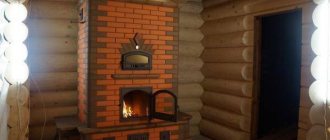The basis of any heater is the process of heat release when burning fuel or heating a conductor, in which all the conditions are created for the occurrence of electric current in it. On these foundations, many models of various stoves are built, the individualization of which is ensured by various features. But the most important thing that personalizes each model is the useful energy output, defined as efficiency. That is, all design improvements are aimed at increasing, at fixed costs, the share of energy converted into heat and used to heat the room.
You can work on the task in several directions.
- Increased combustion intensity. This will increase the energy released per unit time, but the efficiency often decreases as fuel consumption increases.
- Long burning technology. It is based on reducing intensity by limiting air access. As a result, the share of the released heat can be increased.
- Increased heat transfer efficiency. Many developments are based on the idea that the quality of room heating can be improved due to more efficient heat transfer. Convector ovens operate in this direction.
Modern metal heating device
Principle of operation
Convection ovens can use almost any type of fuel to heat your home. This can be agricultural waste, firewood, fuel oil, pellets, briquettes, etc.
In fact, the type of fuel does not matter, because the principle of operation always remains the same and heating occurs due to the rapid supply of hot air through special holes in which pipes are welded into the body.
The supply of cold air is ensured by the fact that there are structures in the lower part through which cold air is drawn in. When the oven is heated to high temperatures, air circulation occurs very quickly.
Drying the oven
It may take from 3 to 8 days to dry the oven. To dry, you need to heat the oven for a short period of time. All doors must be open during drying.
After a few days, when the stove turns grayish-brown and the seams have dried, you can move on to a more intense fire.
Device
The heating design consists of several important elements:
- gate;
- mounting location for the chimney;
- surface for heating food (optional);
- convection pipes;
- secondary air supply jets;
- fuel supply door;
- gas guide flaps;
- holes for hot air outlet;
- grate;
- hole for cold air entry.
What are the temperature conditions, how does it work, and what is cooked?
Standard devices have a temperature range of 200 degrees. The best option is an oven with a temperature range of 45-260 degrees. Convection equipment has several heating modes. The following describes what modes there are and how to find out when to use them and what you can cook (oven) in it:
- Top mode. It is used when you need to fry ready-made dishes, casseroles, or cook lightly fried vegetables on the grill.
- Lower mode. Good for cakes. An excellent result is achieved if you place the dish in the central part of the oven.
- Grill. Used for quick baking and frying kebabs, chops, sausages, and bacon.
- Double grill. In this mode, two heaters are used at once. Thanks to the high power, cooking time is reduced and you can grill large pieces of meat.
- Top and bottom modes. A common heating method that allows you to cook cakes and other dishes.
Species and types
The operating principle of such furnaces is the same, but there are several types of this design, which differ from each other in a number of characteristics.
Firebox type
- Wood-burning (solid fuel). If this is a brick version, then it is a fairly large structure that is laid out in houses on a separate foundation. Their design initially includes convection channels next to the firebox. Essentially, an empty space and a hole at the bottom are left around the firebox, through which cold air will be drawn in. If these are metal structures, then they will not have much weight and require the installation of a foundation. They are already completely ready, so the buyer only has to choose the appropriate option based on the thickness of the metal layer, as well as the dimensions of the structure.
- Gas. There are also two options available here. This can be a stationary convection oven for cooking and heating the room. It is installed in a selected location in the room in such a way as to heat the house. There is also an alternative option in the form of a special fireplace that can be installed in any room. This design runs on bottled gas, but it is also possible to connect a main gas pipeline to this structure.
- Electric convection oven. One of the most common stove options. They are also called electric convectors, which can heat a room very quickly and efficiently. The advantage of this type of design is the possibility of its transportation due to its compact dimensions and the presence of mains power.
Material
A convection oven can be made from materials such as:
- Cast iron. This is a common material from which both the external and internal parts of the structure can be made. Thanks to this material, its high performance and attractive appearance are ensured.
- Hardened metal. This is also a popular solution for pre-fabricated stove structures. It is important that the thickness of the metal sheet in places that are subject to the greatest thermal load is not less than 4 mm. In this case, the product will serve the buyer for many years.
- Brick. This is the heaviest option, which requires independent masonry and does not have ready-made solutions. That is why it is worth paying attention to the issues of laying the foundation. It is also important to correctly calculate the dimensions so that its power is sufficient to meet the needs of several selected rooms.
What properties should a convector wood stove have when heating a dacha?
Of course, convector systems are multifunctional and suitable for almost any purpose related to heating a home.
But, for example, a living space and a country house are two completely different environments that require an individual approach when choosing a stove. Sudden temperature changes should be taken into account, so the stove needs to be heated stronger or weaker - it all depends on the situation and meet certain standards:
- It should distribute heat evenly throughout the day.
- The outside temperature should be 90-95 degrees.
- With low fuel consumption, the room temperature should remain stable.
- The entire oven should heat evenly.
- It should not have cracks, as this can lead to the release of harmful gases directly into the house.
- The size of the firebox should be taken into account; the larger it is, the longer the combustion process will take place and the heat will be retained for a longer time.
- The mechanism itself must function stably for 20 years.
- The appearance of the stove is also very important for the overall atmosphere.
The most economical options
The quality of home heating determines not only the reliability of the structure, but also what materials are used and in what quantities. The most common option is considered to be stoves with a gas-generating effect .
They contain a large amount of firewood, the top layer slowly smolders, and the bottom one waits its turn. This result can be obtained as a result of pipe draft with blower valves. Their efficiency in heating a house is 75-85%. Wood-burning gas stoves are well suited for summer cottages. Gas-generating furnaces with a large column are considered to be another option for economical heating. Firewood, peat, coal or other combustion materials are placed in it at full height. Fill everything with fuel on top and cover it. Combustion air is supplied from above through a pipe.
The process of burning material occurs at the top, gradually moving lower. The combustion rate in the stove can be adjusted using a damper . It operates with wood for up to 2 days (without refueling), and with coal it can heat a house for up to 5 days.
There are stoves with automatic loading of wood. Such designs supply fuel on special disks 10–15 cm thick . The mechanism itself is a very complex system.
Wood-burning stoves with a water circuit are another type; their smoke channel is lined with heat transfer material. Thermal gases pass through special valves, giving off heat to the water. To install it, you need to build a foundation with a heat-insulating pad.
Advantages and disadvantages
Advantages:
- no need to use electricity (except electrical);
- high level of efficiency, more than 80%;
- it is possible to control the level of combustion;
- There are options on sale for heating up to 100 or even more cubic meters;
- can be used for a home, cottage, hangar or change house;
- long operating time from one bookmark;
- high level of efficiency on any fuel;
- possibility to purchase an option with a cooking panel.
Flaws:
- some stoves can emit hazardous combustion products and are suitable for installation only in non-residential premises;
- if you want to install it in a residential building, it will be difficult to coordinate such an installation with firefighters;
- ash flies out through the pipe and pollutes the surrounding area.
A simple option for laying out the oven
This option is suitable for beginners. The size of such a furnace will not exceed 0.5 m2.
- There is no need to lay a foundation for it - you will need a strong board.
- It must be isolated from water with a special solution.
- A layer of sand is applied to the board, after which you can begin laying.
- The first row is laid, then the asbestos cord is wrapped and the door is installed.
- To lay out the third row, fireclay bricks are needed. Then the ash pan and grille are installed.
At the final stage, the chimney is laid by laying bricks on an edge and installing a pipe.
How to choose?
To choose a quality device, you need to decide on your needs and pay attention to the option that best suits them.
For a summer residence, it is recommended to choose solutions that have a surface for heating food. For home use in small spaces, electric options are the best. They will be a mini oven with convection.
When purchasing, you should pay attention to such indicators as:
- power;
- dimensions;
- material of manufacture;
- presence of a hob;
- installation safety;
- fuel used.
Models for home
- Flames KP-2. This stove has small dimensions, its weight is only 44 kg and there is a 40 liter combustion chamber. It is suitable for use in cabins, because it helps to uniformly heat the room.
- Flames KP-4. This oven is slightly larger in size. It has a power of 4 kW, so it can be used for medium-sized rooms. It has a simple design and attractive appearance.
- Furnaces of Professor Butakov. This option is suitable for heating your own home. It can be installed in the basement. The design works with solid fuel and consumes very little of it.
- Teplodar Matrix 100. This design has the advantage of being compact. At the same time, it can quickly heat about 100 cubic meters of area. It has a glass heat-resistant door and a two-channel afterburning system.
- Heater 100. There are also smaller models, so you should choose the appropriate option based on your needs. This stove can heat up to 100 cubic meters. The body is made of hardened steel. Best suited for household use.
Preparing for furnace installation
At the first stage, you need to select high-quality materials for building the stove. Ceramic, silicate, and refractory bricks are suitable here.
Fireproof materials are the optimal solution, but it is more often used for exterior decoration.
The next step is to prepare the solution. You will need clay for the solution. It must be remembered that red clay is required for red colored bricks, and appropriate clay for fireclay bricks. The best solution is to purchase a special mixture.
- When installing the stove, it is necessary to take into account that it is not advisable to place it next to an external wall.
- A stove located in the middle of the room will divide the room into zones.
- The stove located between the rooms will serve as a partition.
Conclusion
A high-quality home convection oven can be used both to heat a room and to cook food on a special panel. At the same time, a household convection oven has significant differences from one intended for industrial use. Household heating can heat up to 100 cubic meters. In rare cases, options up to 600 cubic meters are purchased, but this is only relevant for large private houses.
There is also a separate type of combi oven in which food is prepared. This is a common technique for restaurants, but the principle of steam generation in it is the same as in standard ovens of this design. Before making a choice, you need to take into account your needs and the dimensions of the device, as well as determine the location for its installation.
Oxygen converter melting process description
An oxygen converter is a pear-shaped steel vessel. Its interior is protected by resin-dolomite (base) brick. The capacity of the steelmaking unit varies from 50 to 350 tons. The vessel is located on axles and is capable of rotating around a horizontal axis, which allows you to freely pour cast iron into it, add other additives and merge metal with slag.
To obtain the final product, not only cast iron is poured into the converter, but also additives are added. These include:
- scrap metal;
- slag-forming materials (iron ore, lime, feldspar, bauxite).
The converter method with oxygen purging involves pouring cast iron heated to 1250–1400°C into the converter. By placing the converter in a vertical position, oxygen is supplied to it. As soon as blowing has begun, the remaining components that make up the slag are introduced into the molten cast iron. Mixing of cast iron with slag is carried out under the action of blowing.
A special feature of the main slag is its high content of calcium oxide and iron oxide, which contribute to the removal of phosphorus at the beginning of blowing. If the phosphorus content exceeds the required value, the slag is drained and a new one is added. Oxygen purging is completed when the carbon content in the final product meets a certain parameter. After this, the converter is turned over and the steel is drained into a ladle, where deoxidizers and other additives are added.
Related video: Basics of oxygen converter production
Selection of questions
- Mikhail, Lipetsk — What discs should I use for cutting metal?
- Ivan, Moscow - What is the GOST for rolled sheet steel?
- Maxim, Tver - Which racks for storing rolled metal products are better?
- Vladimir, Novosibirsk — What does ultrasonic processing of metals without the use of abrasives mean?
- Valery, Moscow - How to forge a knife from a bearing with your own hands?
- Stanislav, Voronezh — What equipment is used for the production of galvanized steel air ducts?
Main advantages
The use of technologies that make it possible to increase the efficiency of a heater without increasing the amount of fuel burned has opened up new opportunities for manufacturers of heating devices. A convection oven for home or industrial premises has some key advantages that allow it to attract the attention of consumers.
- Independence from electricity (with the exception of electric convectors) is in demand among residents of suburban areas that experience long-term power outages. Indeed, in the most difficult conditions, a metal stove can be heated with almost any type of fuel. The only recommendation is not to use plastic products or any paraffin-containing materials, as this can lead to premature cleaning of the chimney.
- Uniform heating not only affects the degree of comfort, but also reduces the time it takes to warm up the room. Today there is no more effective phenomenon than convection. Therefore, this type of heat transfer is used twice: when transferring energy to cold air and when distributing heated air throughout the room.
- Convection ovens are one of the few types of devices that allow you to effectively control and regulate the intensity of combustion.
- The possibility of using long-burning technology increases the interval between adding fuel portions to ten hours.
The list of positive qualities is not exhaustive, since the task was to identify precisely the distinctive features of the design.
A convection oven is a type of oven that has high efficiency, can quickly heat a room and is economical in terms of fuel use. The shape of this furnace resembles a cylinder with pipes welded into the body.
The role of convection in heating a room
Heat in the house appears due to heated air. Even infrared emitters heat objects in the room, which, in turn, release energy to the surrounding air. But its thermal conductivity is too low, so heat transfer can only be accomplished through convection, that is, the movement of the air masses themselves.
The heated air rises upward under the influence of buoyant force. Cold air from neighboring areas enters the freed space. The air cools at the top and gradually falls down. This is how natural convection occurs, thanks to which uniform heating of the room space is possible.
In the process of transferring heat from the working fluid (let's call the heated elements of the furnace) to the coolant, whose role is played by air, convection will play a key role, ensuring effective heat exchange and increasing the overall share of useful energy. It’s worth mentioning right away that this is not the only way to transfer heat from the stove to the room. Do not forget about radiation and the penetration into the room of some combustion products that have a high temperature.
If there were no convection, then heat from the furnace would be transferred by conduction. The nearby layers of air would have a high temperature, but further the heating process would stop due to low thermal conductivity. Convection ensures the entry of a new batch of cold coolant and its removal after heating. This principle is used as the basis for the operation of convection ovens.
